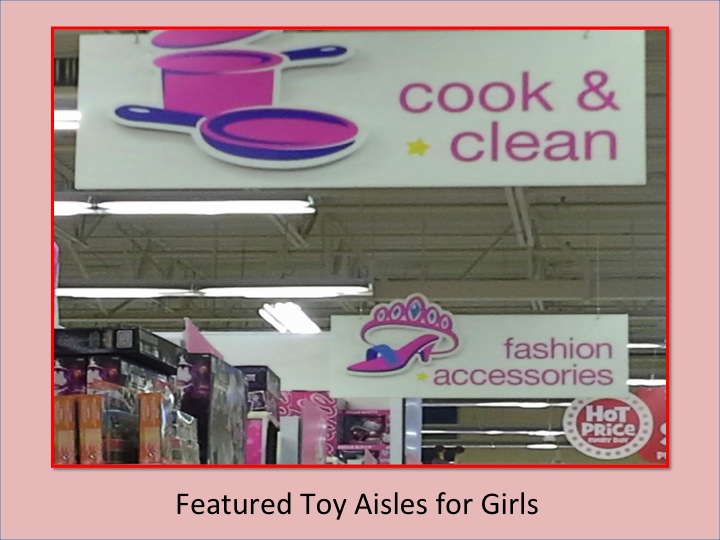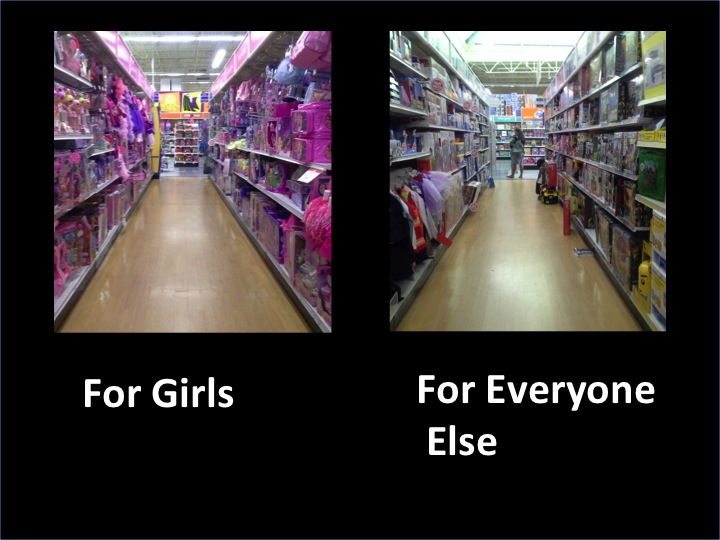
Since day one of the gay marriage debate, the "traditional marriage" advocates have leveraged cries of indignation and hyperbolic circular arguments to make their points. Most of these arguments list the many things that same-sex couples supposedly cannot do, ignoring the fact that these are things that we not only can do but are already doing. What all the irrational statements have in common is one foundational belief that its advocates desperately want to "protect": that men and women hold mutually exclusive roles in the family, which means that neither of those roles can or should be filled by a member of the opposite sex.
The anti-gay advocates rail against parents like me because they fear that I am incapable of fulfilling a role not defined for me. They say that I will deprive my children of the things that, allegedly, only a mother can provide. It seems self-evident to them that, no matter how good a parent I may be, I will never be a "mom," a role that's never been specifically defined but which seems to be understood by thousands nodding in agreement.
There have been peer-reviewed studies on whether these concerns are truly relevant to the well-being of children, and the scientific consensus is that such fears are baseless. Those studies, along with mounds of expert testimony, were presented during legal arguments before the U.S. Supreme Court several months ago, and as a result of the historic Windsor v. United States ruling, the domino effect of marriage equality has started to spread throughout the United States.
However, the legal equality that has just started taking hold will not translate into real freedom on the ground until gender essentialism is seen as the falsehood that it is. As it related to marriage equality and my right to be a parent, I wanted the fallacy exposed for my benefit. Now, as it relates to the ideas that children are exposed to as they grow up, I want it exposed for the benefit of my kids.
I have to confess that I was oblivious to how gender essentialism plays out for kids until I heard about the work of a grassroots organization in the UK called Let Toys Be Toys. They have persuaded Toys 'R' Us in the UK to stop marketing toys specifically to boys or girls. Moving forward, toys will be presented as gender-neutral so that they may attract whatever child finds them interesting and compelling. What a concept!
My first reaction was passive agreement. It made sense to me, but was the in-store marketing really such a problem? I decided to look at it further, with a fresh set of eyes.
I went online. I found the Toys 'R' Us website curiously disturbing. They definitely segregated boys' toys from girls' toys, and each had its unique, predetermined subcategories. Boys had action-oriented categories, and girls had homemaking- and beauty-oriented categories. Even more intriguing were the subcategories that were the same for boys and girls, like art and electronics. Each of those subcategories contained the same items, plus a few extra items for the girls. But even the items that were the same for boys and girls were color-coded for gender. Boys had multi-colored items, like normal, adult-oriented items. Girls had them in pink. It became obvious to me that even in areas that are essentially the same for boys and girls, the gender message is clear: separate but theoretically equal. Sort of like having the same job but different pay scales and career paths.
When I went into our local Toys 'R' Us store, the differences were not subtle. As I looked, the lyrics of Cher's recent hit song -- "Tell the truth: This is a woman's world" -- played in my mind. My thought was, "Cher has not been in a toy store recently."
Mega conglomerates like Toys 'R' Us are making sure that it won't be a woman's world for a long, long time. This should be a woman's world. Women make up almost 51 percent of the United States population, but toy marketing clearly tells little girls where their place in the world is. It is a pink land that exists somewhere between the easy-bake kitchen and the frivolous, glitzy fashion world, and nowhere else. It is far from a woman's (or a future woman's) world unless we define that world as one of choice and pursuit of individual skills, aptitudes and talents, regardless of gender.

In the world of toy marketing, decisions have been made and guidance put in place for kids of both genders, but with a heavy emphasis on segregation of girls. A walk down the toy aisle programs eager, impressionable, wide-eyed young consumers to think in gendered ways and gives them answers to things that they have yet to question for themselves. And this is insidious not only for transgender youngsters but even for those who find that their gender expression is completely consistent with their birth-assigned sex. For the former, it creates an intense pressure to identify in ways that are contrary to how these children feel innately. For the latter, it removes all choice beyond a set of predetermined roles.
There were six aisles designated for toys for girls. There was only one with a sign that said "boys," but its blue color coding extended to several aisles. The subcategories in the blue: sports, action figures, construction. The girls' aisles were pink. Pink signs, pink toys, pink packages. Pink, pink, pink. All the other aisles in the store blended with the boys' aisles and provided a full spectrum of colors and variety.

The girls' section was a pink bubble. The themes: fashion, cooking and cleaning. The promotional words on the packages were fun and frivolous. In contrast, the toys that were meant for boys communicated, literally and figuratively, concepts such as leadership, command, speed, agility, skill, might and success.
I got the message then and there. If you are a girl, your aspirations should be to play at elegance, nurture a baby doll, and practice cooking and cleaning. If you are a boy, you are to aspire to a persona of power. You are to build physically, train and excel.
I really could not believe what I was seeing in front of me in this store that I had visited dozens of times before. For a decade I had walked through this mecca of child consumerism oblivious and complacent. How could I have missed it? I felt guilty for having participated in this cultural child programming. But to be honest, when I was there with my sons, I was in defense mode against a constant barrage of the "gimmes," and it took all my willpower and focus to keep them in control, to the point that I was blind to the propaganda all around me.
But even though I was not necessarily conscious of the gender-specific marketing of toys, I already understood that it was having an effect. A few nights before that visit to the local Toys 'R' Us store, my sons and I were at a restaurant that gives "kid gifts" with their meals.
"Darn! They gave me a girl toy," declared my youngest son Jesse as he held up a little Care Bear figure.
"What do you mean?" I asked. "It's a Care Bear. You used to have Care Bears. You used to love Care Bears."
"It's a girl toy, Dad," he curtly informed me.
"How do you know?" I pressed.
"We checked with our friends," he explained. "None of the boys play with them or watch them. They are for girls. They have pink on them." He shot me a reprimanding glare. Apparently our family had not gotten the memo, and in his mind this conversation was long overdue.
I let the conversation go for the time being, but I felt a sense of failure. My sons were never raised with the idea that any toy was off-limits to them because of their gender. Obviously, peer pressure had intervened outside my watch. But was that all it was? Where and when did their peers "get the memo"? Now I know.
After my trip to the local Toys 'R' Us store, I decided to look at the senior executive teams of Toys 'R' Us and Mattel to get a sense of who the people behind the toys and the gendered messages are. Of the twenty-some top decision makers across both companies, 17 are middle-aged men. Three are women (and one of these is in human resources, so she's not involved in market strategies). It reminded me of the GOP's "war on women" and all the middle-aged men going before Congress to testify about women's reproductive rights.
Despite the fact that women make up almost 51 percent of the population in the United States, they account for only about 4 percent of Fortune 500 and Fortune 1000 CEOs. Women make up only 20 percent of the U.S. Senate and 18 percent of the U.S. House of Representatives. I have heard woeful excuses for this disproportionate representation since the mid-1970s. Seriously, in 40 years, don't you think there are some real, ingrained biases in place that are blocking us from achieving a real gender balance?
There are probably those who think that I am being overly harsh against the pink bubble. Pink is a nice color. I like pink. However, its institutionalization as a prison around little girls is completely arbitrary, and it is a recent development, dating to the 20th century. At the turn of that century, all children wore white dresses, had long hair and looked like, well, little girls, even if they were little boys. As women's power and autonomy rose with the right to vote and the increased ability to own property and rise in the workforce, our culture seemed to react oppressively, and the color coding started coming into play. (That coding was so arbitrary that the June 1918 issue of Infant's Department, a trade magazine for manufactuers of baby clothes, advised, "There has been a great diversity of opinion on this subject, but the generally accepted rule is pink for the boy and blue for the girl. The reason is that pink, being a more decided and stronger color, is more suitable for the boy, while blue, which is more delicate and dainty, is prettier for the girl.")
We have all seen the ramifications of fighting the pink bubble. Women who fight to free themselves of its constraints are targeted by misogyny, which can be ugly and even deadly. Boys are not immune, particularly gay, bisexual or gender-nonconforming boys who may want to choose things from among the pink bubble's warm, beautiful and artistic offerings. Those boys are slapped down and abused by homophobia, misogyny's equally evil child.
This abusive oppression is a tool used by those who fear people showing aptitude outside the gender roles that they want to impose. They fear men who can "mom" well, and they fear a woman who might be the first female president of the United States.
I want my sons to welcome the pink. I want them to be nurturing, cook well and appreciate beautiful elegance. God knows I would love for them to clean more. And I want their female peers to be encouraged to explore all their talents as well. Why would we box tomorrow's brilliant scientist, military hero, sports goddess or architect into a pre-fabricated role without choices?
Since my trip to the toy store, I am ever hopeful that organizations like Let Toys Be Toys will succeed in their mission. The song that is now playing in my head is no longer the one by a defiant Cher but another by a softly optimistic John Lennon, with my own minor modifications:
"Imagine no kid gender classification
I wonder if you can
No need for pink or blue aisles
A sisterhood of man
Imagine all the people
Sharing all the world
You may say I'm a dreamer
But I'm not the only one
I hope someday you'll join us
And the world will live as one."
The challenges of this world are escalating, and we need the talents of every individual to overcome them. Why on Earth would we intentionally limit the potential to accomplish a given feat to only half the population?
